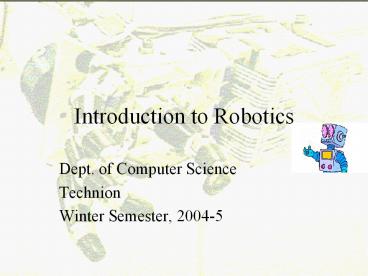Introduction to Robotics - PowerPoint PPT Presentation
1 / 23
Title:
Introduction to Robotics
Description:
Introduction to Robotics Dept. of Computer Science Technion Winter Semester, 2004-5 I2R Information Sheet Instructor: Hector Rotstein Phone: 054-2151054. – PowerPoint PPT presentation
Number of Views:100
Avg rating:3.0/5.0
Title: Introduction to Robotics
1
Introduction to Robotics
- Dept. of Computer Science
- Technion
- Winter Semester, 2004-5
2
I2R Information Sheet
- Instructor Hector Rotstein
- Phone 054-2151054. Evenings only!
- Office hours We 1730-1830
- Fri 1130 - 1230 (appointment only)
- E-mail hector_at_ee.technion.ac.il
3
I2R Information Sheet
4
Bibliography
- John Craig, Introduction to robotics, Addison
Wesley. - G. Dudek and M. Jenkin, Computational Principles
of Mobile Robotics, Cambridge University Press. - Handouts
5
Course Objectives
- At the end of this course, you should be able to
- Describe and analyze rigid motion.
- Write down manipulator kinematics and operate
with the resulting equations - Solve simple inverse kinematics problems.
- Select sensors for performing robotic tasks
- Use sensors to compute robotics localization
6
Syllabus
- A brief history of robotics. Coordinates and
Coordinates Inversion. Trajectory planning.
Sensors. Actuators and control. Why robotics? - Basic Kinematics. Introduction. Reference frames.
Translation. Rotation. Rigid body motion.
Velocity and acceleration for General Rigid
Motion. Relative motion. Homogeneous coordinates. - Robot Kinematics. Forward kinematics. Link
description and connection. Manipulator
kinematics. The workspace.
7
Syllabus (cont.)
- Inverse Kinematics. Introduction. Solvability.
Inverse Kinematics. Examples. Repeatability and
accuracy. - Basic Dynamics and Control. Introduction.
Definitions and notation. Laws of Motion. Robot
control. - Trajectory generation. Introduction. General
considerations. Path generation. - Introduction to mobile robots. Mobile Robots hw.
- Sensing and localization
8
Policies and Grades
- There will be six homework assignments, one
mid-term and project. - Tests are open book. The homeworks will count 4
each towards the final grade, the project 40 and
the final 36. - The worst homework will be given 20 of the
normal weight, while the best will be given 180
of the normal weight.
9
Policies and Grades (cont.)
- Collaboration in the sense of discussions is
allowed. You should write final solutions and
understand them fully. Violation of this norm
will be considered cheating, and will be taken
into account accordingly. - Can work alone or in teams of 2
- You can also consult additional books and
references but not copy from them.
10
Policies and Grades (cont.)
- Required homework will be due before the
beginning of practice, at the course mailbox. - Late homework will be accepted up to one week
after the due date, will receive a maximum grade
of 80 and loose 10 for each delay day after the
first one. However, bonus problems must be handed
in on their due date.
11
Robot Examples
12
The Three Laws of Robotics
- A robot may not injure a human being, or, through
inaction, allow a human being to come to harm. - A robot must obey the orders given it by human
beings except where such orders would conflict
with the First Law. - A robot must protect its own existence as long as
such protection does not conflict with the First
or Second Law. - Zeroth law A robot may not injure humanity, or,
through inaction, allow humanity to come to harm
13
Robot Demos
14
A Brief History of Robotics
- The word robot introduced by Czech playwright
Karel Capek robots are machines which resemble
people but work tirelessly. - His view is still to be fulfill!
Best soccer player ever
Best robot player ever
15
A Brief History of Robotics II
- Definition
- a robot is a software-controllable mechanical
device that uses sensors to guide one or more
end-effectors through programmed motions in a
workspace in order to manipulate physical
objects. - Todays robots are not androids built to
impersonate humans. - Manipulators are anthropomorphic in the sense
that they are patterned after the human arm. - Industrial robots robotic arms or manipulators
16
History of Robotics (cont.)
- Early work at end of WWII for handling
radioactive materials Teleoperation. - Computer numerically controlled machine tools for
low-volume, high-performance AC parts - Unimation (61) built first robot in a GM plant.
The machine is programmable. - Robots were then improved with sensing force
sensing, rudimentary vision.
17
History of Robotics (cont.)
- Two famous robots
- Puma. (Programmable Universal Machine for
Assembly). 78. - SCARA. (Selective Compliant Articulated Robot
Assembly). 79. - In the 80 efforts to improve performance
feedback control redesign. Research dedicated
to basic topics. Arms got flexible. - 90 modifiable robots for assembly. Mobile
autonomous robots. Vision controlled robots.
Walking robots.
18
Robot Classification
- Robotic manipulator a collection of links inter-
- connected by flexible joints. At the end of the
robot there is a tool or end-effector. - Drive Technology. Which source of power drives
the joints of the robot. - Work-envelope geometries. Points in space which
can be reached by the end-effector. - Motion control method. Either point-to-point or
continuous path
19
The Course at a Glimpse Kinematics
- F(robot variables) world coordinates
- x x(?1,?, ?n)
- y y(?1,?, ?n)
- z z(?1,?, ?n)
- In a cascade robot, Kinematics is a
single-valued mapping. - Easy to compute.
20
Kinematics Example
- ?1 ?, ?2r
- 1? r ? 4.5
- 0 ? ?? 50o
x r cos ? y r sin ?
21
Inverse Kinematics
- G(world coordinates) robot variables
- ?1 ?1(x,y,z)
- ?
- ?N ?N(x,y,z)
- The inverse problem has a lot of geometrical
difficulties - inversion may not be unique!
22
Inverse Kinematics Example
Make unique by constraining angles
23
Trajectory Planning
- Get from (xo, yo, zo) to (xf, yf, zf)
- In robot coordinates ?o ? ?f
- Planning in robot coordinates is easier, but we
loose visualization. - Additional constraints may be desirable
- smoothness
- dynamic limitations
- obstacles

